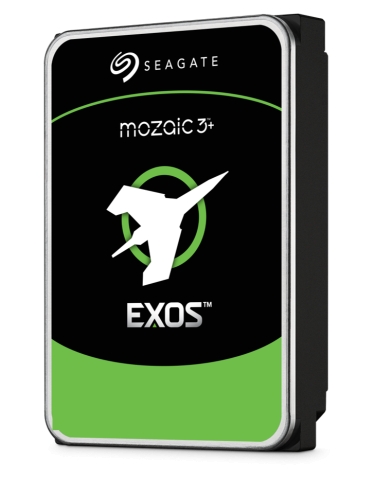Seagate's new Mozaic 3" platform delivers unprecedented areal density of 3TB+ per platter, up to 30TB+ in a single 3.5" drive. The company expects to ship a million units by mid-2024. The new tech is built on heat-assisted magnetic recording (HAMR), and gives a roadmap for Mozaic 4, Mozaic 5, and beyond, with platter capacities of 4TB+, 5TB+, and more.
The Mozaic 3+ platform powers Seagate's flagship Exos product family, with orders already in place to hyperscale cloud customers. The drives provide far greater storage capacity in the same physical space than previous disks, and a lower cost per terabyte than previous disks, too.
The tech behind the platform to increase the number of bits that can be stored on a platter - known as areal density - was a significant achievement pushing the boundaries of physics by tightly packing smaller magnetic bits while keeping them stable at room temperature through a special platinum alloy material, and with a newly designed tiny laser to read and write them. You can hear more in our iTWireTV interview with Seagate executive vice president and chief commercial officer BS Teh.
|
|
Upgrading from a 16TB conventional perpendicular magnetic recording (PMR) drive to an Exos 30TB Mozaic 3+ technology drive effectively doubles in the same footprint. For data centres seeking to lower their storage acquisition and operational costs, it's quite a no-brainer. And, as well as fitting more data in the same space, the new Exos drives bring a 40% improvement in per-terabyte power consumption. With sustainability and energy costs as a top priority for large-scale data centres, the drives also offer a 55% reduction in embodied carbon per terabyte, when comparing a 30TB Mozaic 3+ drive with a traditional 16TB PMR drive.
Seagate is already experiencing strong demand from data centre customers and expects to move into a volume ramp by the end of the first quarter 2024.
“Seagate is the world’s only hard drive manufacturer with the areal density capability to get to 3TB per platter and with 5TB on the horizon,” said Seagate CEO Dave Mosley. “As AI use cases put a premium on raw data sets, more companies are going to need to store all the data they can. To accommodate the resulting masses of data, areal density matters more than ever.”
“The Mozaic 3+ platform represents more than just HAMR technology,” Mosley noted. “It comprises several industry-first innovations that we’ve integrated to help us scale areal density.”
Here are a few highlights:
1. Superlattice Platinum-Alloy Media. The fundamental physics of higher-density recording requires smaller media grain size at the nanoscale. The challenge here is that smaller grains are more unstable. Legacy alloys do not provide sufficient magnetic stability for effective and reliable storage. In Mozaic 3+ hard drives, the media alloy uses a pioneering iron-platinum superlattice structure, which significantly increases the magnetic coercivity of disk media. This allows for precise data writing and unprecedented bit stability.
2. Plasmonic Writer. Since the media are made magnetically “harder” to prevent instability, the design requires a revolutionary writer—a marvel of miniaturisation and precision engineering that is Seagate’s unique implementation of HAMR. Anchoring this technology is a nanophotonic laser, which produces an infinitesimal heat spot on the media surface to reliably write the data.
Seagate plans to vertically integrate the nanophotonic laser into the plasmonic writer sub-system. “Developing this unique laser technology in-house for Mozaic 3+ will ensure even greater efficiency and yield to support rapid scaling of volume production,” Mosley said.
3. Gen 7 Spintronic Reader. Smaller grains of written data are only useful if they can be read. Integrated along with the sub-components of the plasmonic writer, the reader also needed to evolve. Incorporating quantum technology, Mozaic 3+ includes one of the world's smallest and most sensitive magnetic field reading sensors.
4. 12nm Integrated Controller. Efficiently orchestrating all this technology called for an integrated controller, a system-on-a-chip, developed entirely in-house. This sophisticated application-specific integrated circuit delivers up to 3 times the performance compared to prior solutions.
“Hard drive areal density improvements are critical for economically and efficiently expanding the installed base of hard drive-based mass storage, especially in data centres,” said IDC Global DataSphere research vice president John Rydning. “Seagate’s innovative areal density breakthrough is timely and will enable it to deliver increasingly higher capacity hard drive products for many years.”
In addition to data centres, Mozaic 3+ storage technology will enable a wide range of use cases, ranging from enterprise, to edge, NAS, and video and imaging applications (VIA) markets.







